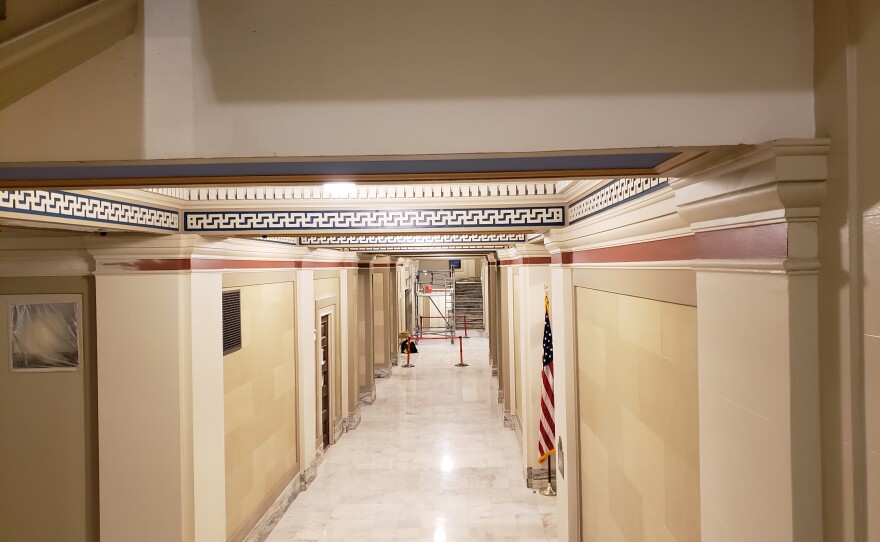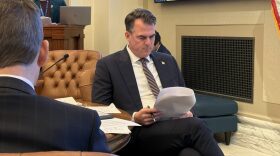When elected officials and visitors descend on the State Capitol Building for the start of the legislative session on February 3rd, they will see some dramatic changes. Trait Thompson, Capitol Project Manager for the Oklahoma Capitol Restoration Project, told KGOU's Dick Pryor and eCapitol's Shawn Ashley what they can expect.
TRANSCRIPT:
Dick Pryor: This is Capitol Insider, your weekly look inside Oklahoma politics, policy and government. I'm Dick Pryor with eCapitol news director Shawn Ashley. And our guest is Trait Thompson, Capitol Project Manager for the Oklahoma Capitol Restoration Project. Trait, welcome.
Trait Thompson: Thank you. It's great to be here.
Dick Pryor: Good to have you, Trait.
Shawn Ashley: The 2020 legislative session gets underway on February 3rd. A lot of people will be going to the Capitol to hear the governor's State of the State speech. But, the building itself has changed a lot since many people were there at the end of the last legislative session. What are some of the most obvious changes to the building since the last session?
Trait Thompson: We're coming off our busiest legislative interim period in the history of the capitol restoration project thus far. Just to give you a little bit of perspective. We were building at one point about six million dollars a month in construction. We had over 300 construction workers in the building. And when people come back, first thing that they will probably notice, the most noticeable thing, is that the fourth floor rotunda area will be closed off. We have it in scaffolding right now.
We're beginning the process of restoring all of the original plaster. We will be repainting in there. We will be restoring the marble on the balustrade and also on the floors. And so the corridor that goes around the rotunda will still be open. Access to the committee rooms will be open, but that middle part of the rotunda will be closed.
The great news is that the second floor rotunda has reopened now. It's been completely restored again and has the new paint scheme that we're installing in the entirety of the Capitol building. The treasurer's office is still going to be located off site. They're located at Britton and May right now and will be until the early part of May until they come back to the Capitol. In March, we'll be moving the lieutenant governor's office from the second floor to the first floor.
But other than that, most things will be pretty much the same. Parking will remain where it has been. The east and west entrances will be open as well as the south entrance to the building. I think the biggest thing that people will notice is just that fourth floor rotunda area.
Dick Pryor: Typically, a lot of events are held on the fourth floor during the legislative session. Will those now be on the second floor?
Trait Thompson: Most of them will be. We have opened the second floor (and it’s) available for the public to reserve for different events and activities and displays and the things that normally happen on the fourth floor and sometimes happen on the second floor. So,the public can still reserve that area. But we've also encouraged people to perhaps look at some other areas around the Capitol. For example, the Judicial Building has some space available. We have the Concourse Theater that's located underground between the Will Rogers and Sequoyah Buildings that can be reserved, as well. And then, of course, if you go out a little bit farther, you've got Philips Pavilion at the Governor's Mansion and you have the History Center, as well.
Shawn Ashley: During the 2019 legislative session, the snack bar moved from the fourth floor where it was located, very near the pressroom, down to the basement and began operations with a dining area. What can people expect to see in the snack bar now that it's relocated and its operations seem to be expanding?
Trait Thompson: Well, first of all, we don't like to call it the basement anymore, Shawn. We like to call it the ground floor because we have changed the whole way that that floor is used. Now, it has a lot of public amenities, and we'll have most of the public amenities that people in the building will use - expanded restroom banks, food service areas, it's going to have a museum in it. And that's going to be the main floor where people will enter the building starting this coming June.
As far as the food service area goes, we now have a dining room that seats 60-plus people, which is far more than has been the capacity has been in the past. And Health Nut Cafe has been running the food service in the building for about three years now. They've done an incredible job. But when we redesigned the kitchen area, we expanded it so that now we could include things like grills and fryers and ranges and ovens.
And so Health Nut, Amir Alavi, is the owner of that. He's been a great partner through this whole process. And so now they're starting to expand their menu. Just this week, they started serving burgers and fries. Over time, I think you'll see more hot food options there kind of in a trial period. Now, to get some processes down and figure out the best way to do it, a session goes on. I think you'll see more food options coming, not just the healthy things you've come to know and love from Health Nut Cafe, but also some of the other hot food items that we've always envisioned for being a part of food service at the Capitol.
Shawn Ashley: You mentioned that in June, the new visitors entrance will open there into the ground floor level. That's probably one of the most obvious pieces of work.
Trait Thompson: People will see as they approach the Capitol, the way that people have been coming into the building now for probably 20-plus years, is a side entrance that was never meant to be the main entrance. And so it was, really, from a functional standpoint, it didn't work very well. People would have to line up outside in the cold and the rain to get into the building. You only had one security station, so you can only process people through so quickly. And then it wasn't a very impressive entrance into the Capitol, as well.
We've designed and are now executing a new visitor entrance that's at the southeast corner of the building. It's been sunken, so it doesn't restrict the view of the Capitol's historic profile. But now we are going to have a large vestibule for it. If we have a lot of people coming into the building at once, there's queuing space inside and then we're going to have two security stations. And now when people come inside the building, they're going to be coming into a place that's meant for visitors. So right when they get inside, across the hall is all of the restrooms, the visitor center that tourism runs, that has the gift shop and where you can get tours.
And now at that same level, once again, food service in the museum. So, we envision it being all of those amenities that someone would need to find in the building would be easy to find because he'd be right there when they entered.
Dick Pryor: Earlier, you mentioned security. Will it be any different this year?
Trait Thompson: So, we have one thing that is different is we've spent quite a bit of money on upgrading the security equipment, the X-ray machines, The X-ray machines that DPS has been using there were from about the 2003-2004 period. They were long past their useful lives. So we have upgraded all of those. But security will pretty much function the way it always has functioned for most of the visiting public entering the building.
Dick Pryor: Is the project on schedule?
Trait Thompson: Project is on schedule. In fact, we're a little ahead of schedule right now. We were initially planning to be done by the end of 2022. We're now projecting to be done in the spring to early summer of 2022. And we may even, as we get farther, we may even push that back a little bit, as well. So we've been working quite hard to make sure that we can finish in a timely manner.
Shawn Ashley: The exterior of the building looks fantastic, having been in that building for more than 20 years now. And you're also doing some work on the roof. What's happening there?
Trait Thompson: We are installing a brand new copper roof system. I always get asked, well, why copper? First of all, it's the historic building material that was there. And one major component of this project is historic preservation. And then copper is also a very durable material, and a well-maintained copper roof should last 80-plus years. So, that project started over a little over a year ago and we're projected to finish it up in late March, early April of this year. At that point, you'll see the large tower cranes start to come down and that will mark the completion of the 60-plus million dollar exterior restoration of the Capitol.
Dick Pryor: What will be next when we get through the legislative session? Looking ahead to the summer, then, what do you do?
Trait Thompson: In the interim this year our main focus on the interior, the building, will be all of the committee rooms on the fourth and fifth floor. So the public will when they come back for the 2021 session, we'll see a vastly upgraded committee rooms and that'll include new finishes. That will include new data wiring that will include new A-V systems. And they should be a lot easier for the public to be able to understand what's going on in those committee meetings and to interact with their legislators.
Shawn Ashley: And you'll also be refurnishing those rooms in such a way to make them more handicapped accessible, I believe.
Trait Thompson: That's right. Accessibility is a major component of this project and it's something that we have wanted to do all throughout. So, ADA is something we do as far as how we design the space. But it's also comes into place with furniture, making sure that we have the proper clearances so that people can move around any room or any area in the way that they should be able to do that.
Dick Pryor: It's been a remarkable transformation of that building. Trait Thompson, well done.
Trait Thompson: Thank you very much. We have a great team.
Dick Pryor: That's Trait Thompson, Capitol Project Manager for the Oklahoma Capitol Restoration Project, our guest. Thanks for joining us.
Trait Thompson: Happy to be here.
Dick Pryor: That's Capitol Insider. If you have questions, email us at news@KGOU.ORG or contact us on Twitter @KGOUnews. You can also find us online at KGOU.ORG or ECAPITOL.NET. Until next time, with Shawn Ashley, I’m Dick Pryor.












